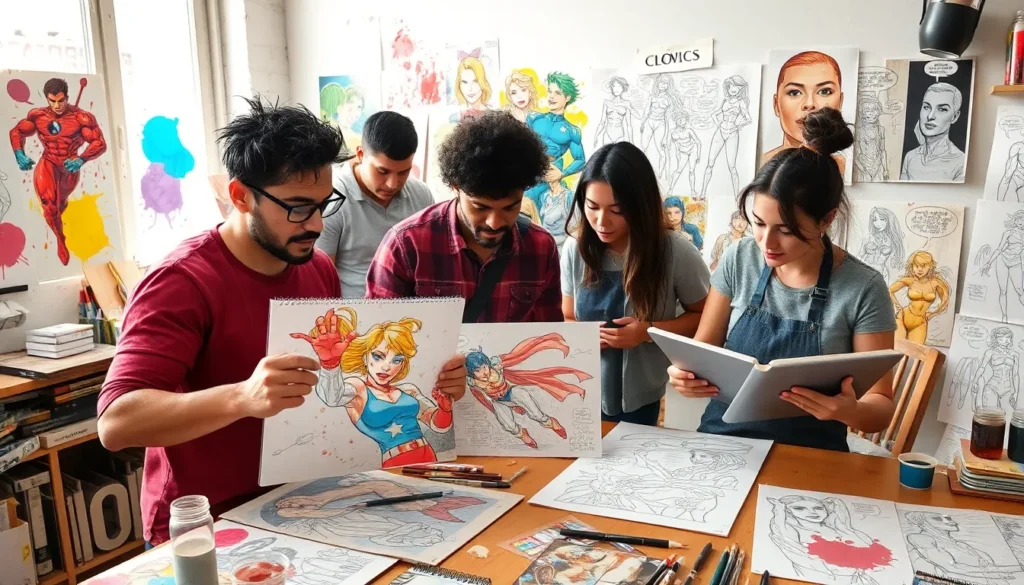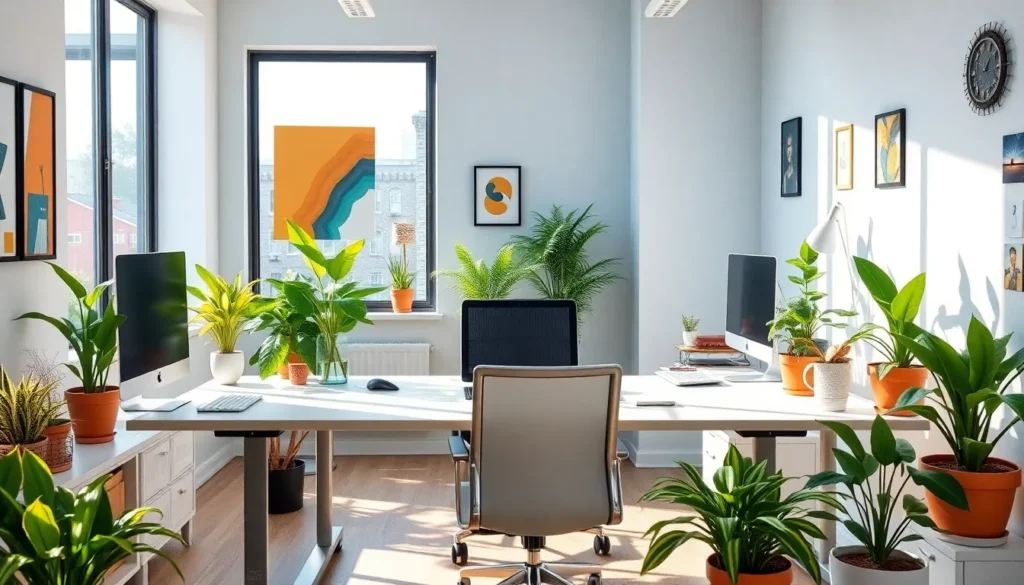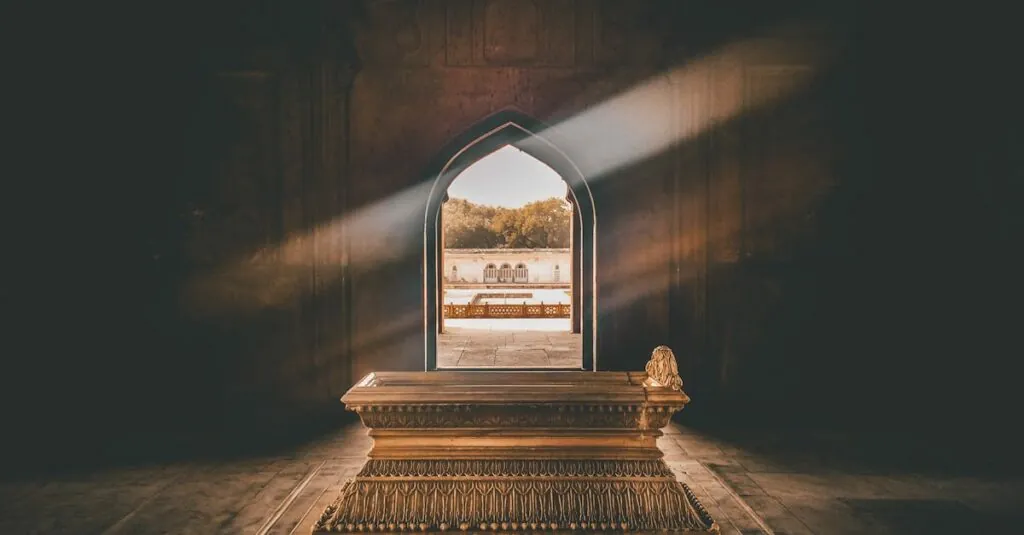Table of Contents
ToggleStep into the vibrant world of Indian interior design, where every corner tells a story and every color has a personality. Imagine a space adorned with intricate patterns, rich textiles, and a dash of tradition that makes even your grandmother’s living room look like a bland hotel lobby. From bold hues to delicate carvings, Indian design isn’t just about aesthetics; it’s a celebration of culture and heritage that transforms homes into havens.
Overview of Indian Interior Design
Indian interior design showcases an impressive blend of tradition and modernity. It reflects the country’s diverse cultures and rich heritage, leading to unique styles that vary across regions. Vibrant colors play a crucial role, with hues often inspired by nature. Textiles, ranging from silk to cotton, contribute texture and warmth, enhancing the overall ambiance.
Patterns also hold significance in this design style, with intricate motifs representing various cultural narratives. Elements like mandalas and paisleys often appear, adding depth to spaces. Use of traditional crafts, such as wood carving and metalwork, provides a distinct character to furniture and decor.
Furniture in Indian interior design often features a mix of functionality and artistry. Heavily carved wooden pieces evoke a sense of history while serving practical purposes. In urban settings, contemporary pieces integrate with traditional elements, creating a harmonious balance between old and new.
Lighting choices stand out in Indian homes, with ornate fixtures casting soft, inviting glows. Incorporating natural light remains essential, guiding the design process. Indoor plants are frequent companions, promoting tranquility and connecting spaces to nature.
Spaces are designed to accommodate gatherings, reflecting the importance of hospitality in Indian culture. Room layouts often encourage social interaction, ensuring that family and friends feel welcomed. This focus on community reinforces the idea that interior design serves more than aesthetic purposes; it encapsulates the essence of life and relationships.
Indian interior design thus transforms homes into personal sanctuaries that celebrate cultural roots while adapting to modern needs. It merges the past with the present, creating spaces that resonate emotionally and visually.
Key Elements of Indian Interior Design
Indian interior design encompasses various elements that create a harmonious and culturally rich environment. The approach blends traditional aesthetics with modern functionality.
Color Palette
Vibrant colors dominate Indian interior design. Shades like deep reds, bright yellows, and lush greens draw inspiration from nature. These colors often symbolize joy, prosperity, and festivity, enhancing emotional connections within spaces. It’s common to find an interplay of warm and cool tones, creating visual interest. Accents in jewel tones like sapphire and emerald further elevate the aesthetic appeal. Color choices also reflect regional influences, showcasing India’s diverse cultural heritage.
Materials and Textures
A mix of materials defines the tactile experience in Indian interiors. Natural elements like wood, stone, and clay provide durability and authenticity. Intricate carvings and handwoven textiles add depth to spaces while celebrating traditional craftsmanship. Fabrics such as silk, cotton, and jute contribute both warmth and comfort. The layering of different textures often creates a cozy atmosphere. Contemporary materials like glass and metal also complement traditional ones, showcasing a smooth balance between old and new.
Traditional Styles vs. Contemporary Trends
Traditional Indian interior design embodies rich regional variations and narratives. Diverse styles emerge across India, reflecting local materials and cultural practices.
Regional Variations
Each region offers unique characteristics, stemming from its history and geography. For instance, Rajasthani interiors showcase vibrant colors and intricate carvings, heavily influenced by royal aesthetics. South Indian designs, with their emphasis on simplicity, often utilize stone, coconut, and terracotta. Eastern spaces frequently integrate bamboo and jute, portraying a connection with nature. Northern designs highlight warmth through textiles and wood, while also incorporating Mughal influences. These regional styles contribute to an eclectic representation of India’s interior design heritage.
Fusion Designs
Fusion designs blend traditional elements with contemporary aesthetics, creating unique interiors. Mixing materials like wood and glass generates striking visual contrasts. Designers often pair ornate Indian furniture with modern decor, achieving harmony between styles. Additionally, vibrant textiles complement minimalist furnishings, enhancing both comfort and aesthetic appeal. Open floor plans promote social interaction while incorporating traditional artwork, bridging cultural heritage and modern living. Such fusion designs enable personalization, allowing homeowners to reflect their identities amid evolving trends.
Cultural Significance in Indian Interior Design
Indian interior design reflects deep cultural significance, infusing spaces with stories and traditions. Traditional motifs, such as mandalas and paisleys, carry historical narratives, creating a visual dialogue with the past. Each element in the design serves a purpose beyond aesthetics, encouraging a connection to heritage.
Colors play a vital role, with a vibrant palette that includes deep reds, bright yellows, and lush greens. These hues symbolize joy, festivity, and region-specific influences. The blend of materials, including wood, stone, and clay, enhances this cultural richness and provides texture.
Craftsmanship shines in furniture design, where carved wooden pieces evoke a sense of history. Contemporary urban settings now often feature these traditional designs alongside modern styles. Such combinations achieve a balance that respects the past while embracing the present.
Social interaction influences layout choices as well. Interiors prioritize communal spaces, aligning with the importance of hospitality in Indian culture. Open floor plans and cozy seating arrangements encourage gatherings, strengthening bonds among family and friends.
Regional variations further highlight India’s diverse cultural tapestry. In Rajasthan, interiors burst with colors and intricate carvings, while South Indian designs favor simplicity with natural materials. Eastern influences bring bamboo and jute into play, showcasing the adaptability of traditional methods.
Fusion designs create unique expressions by mixing traditional elements with contemporary aesthetics. Homeowners can personalize their spaces, merging ornate Indian furniture with sleek modern decor. This synergy fosters environments that resonate emotionally while celebrating rich cultural roots.
Popular Decor Items in Indian Interiors
Decor items play a pivotal role in shaping Indian interiors. Colorful tapestries, often handwoven, add artistic flair to walls. Traditional wooden sculptures, carved with precision, serve as striking focal points. Each piece reflects cultural significance, inviting conversations about heritage.
Terracotta pottery, rich in texture, houses plants or doubles as standalone decor. Ornate brass lanterns enhance ambiance, casting intriguing shadows across the room. Floor cushions, known as “bolsters,” provide comfort and foster communal spaces within homes.
Rug designs, featuring vibrant patterns, infuse warmth underfoot and act as art pieces. Wall hangings, including embroidered fabrics, celebrate regional craftsmanship while adding depth to spaces. These elements combine to create an inviting atmosphere that resonates with both warmth and cultural richness.
Unique furniture pieces, such as intricately carved chairs and tables, blend form with function. Decorative mirrors enhance light and create an illusion of space, often showcasing ornate frames. Beautiful pieces of wall art, capturing the essence of Indian culture, serve as attractive conversation starters.
Each decor item contributes significantly to the overall feel of Indian interiors. Textured cushions and throws provide comfort, while handcrafted artifacts celebrate skills passed down through generations. The combination of these decor items transforms spaces, allowing homeowners to express their personality and cultural identity.
Embracing Indian interior design offers a transformative experience that celebrates cultural heritage while adapting to contemporary living. The vibrant colors and intricate patterns infuse spaces with warmth and character, creating environments that resonate emotionally.
By blending traditional craftsmanship with modern aesthetics, homeowners can curate personalized sanctuaries that reflect their identities. Each decor item serves a purpose beyond mere decoration; it tells a story and enhances the overall ambiance.
Ultimately, Indian interior design stands as a testament to the beauty of cultural fusion, inviting individuals to create homes that are not only visually stunning but also rich in meaning and history.







